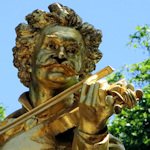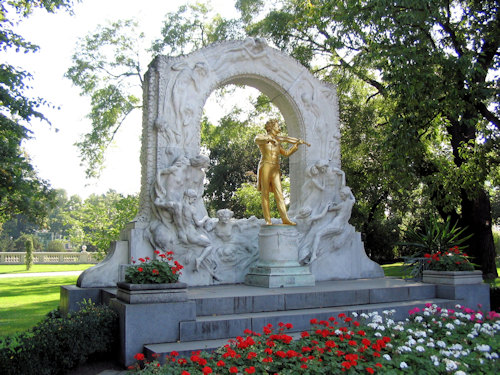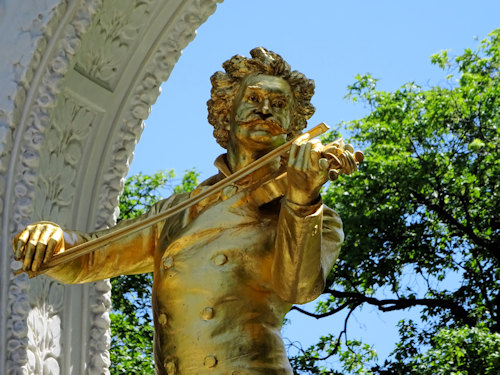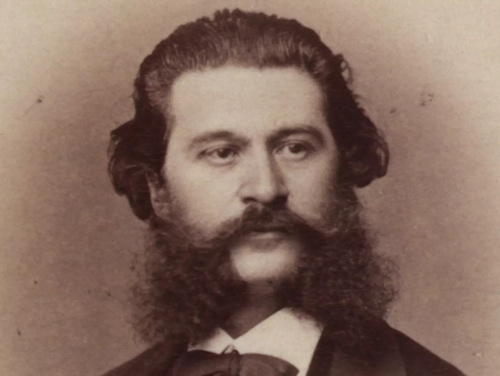
Copenhagen has its little mermaid, Vienna has its golden Strauss. The iconic statue is one of the city’s most popular photo opportunities.
- Golden statue of Johann Strauss II much loved by tourists
- Located in the tranquil Stadtpark city park in the centre
- Opposite the Kursalon concert venue
- See also:
The statue

(A much-photographed musician)
If you’re in the Stadtpark city park and see a polite queue of people with smartphones and cameras, you’ve likely found the famous Strauss monument.
(Also look for harassed parents desperately trying to usher young kids off the podium so people can take their photos.)
The iconic golden figure of Johann Strauss II (1825 – 1899) playing his violin now graces postcards and Instagram pages everywhere. The city of Shanghai even has its own replica.
The rest of the park also hosts a few other tributes to musical greats.
Franz Schubert has a statue, for example, while Bruckner and Lehár also get memorials. And Strauss’s immediate neighbour is the Kursalon, where he once performed. The venue still hosts concerts of his music today.
The statue’s history

(Playing a note that will last through the ages)
The locals call Strauss the Walzerkönig (“King of the Waltz”), which offers a clue to some of his more famous works.
This is the man who gave us the Blue Danube waltz…perhaps the composition most closely associated with Vienna and also the music used to welcome in the Viennese New Year and end the New Year’s Concert.
Anyway, in 1903, shortly after Strauss’s death in 1899, plans were put in place to build a memorial to this Viennese great. Unfortunately, the financing turned out to be trickier than expected, and the outbreak of the first World War didn’t help matters either.
Such problems meant the memorial first saw the light of day on the morning of June 26th, 1921, based on a design by Edmund Hellmer (who also gave us the Goethe monument).
The unveiling ceremony reflected the status accorded Strauss by the city and country. The Wiener Philharmoniker opened the occasion with Strauss’s 1867 Künstlerleben waltz, and accompanied the actual unveiling with a performance of the iconic Blue Danube.
Dignitaries present included the mayor of Vienna, as well as Austria’s president, prime minister and deputy prime minister. The mayor noted in his speech (my translation):
Today is a memorable one for the city of Vienna. It shows that the great sorrows visited on the people by the war are finally beginning to lessen. That Vienna is coming back to life again.

(Johann Strauss photographed by Xaver Massak in 1870. The bewhiskered version of the composer; Wien Museum Inv.-Nr. 76966/2; excerpt reproduced with permission under the terms of the CC0 licence)
The statue has a slightly unusual take on the great composer, with his famous sideburns clearly absent (these were large enough to house a family of ducks). And the gold colour is actually gilded bronze.
Inevitably, spring and summer make the best times for photos, when flowers surround the plinth. But a shot at nighttime can look pretty good, if your camera’s up to the job (mine isn’t).
Incidentally, if you want to see one of Strauss’s actual violins, then pop into the Strauss Apartment on Praterstraße.

(I’m a writer, not a photographer)
How to get to the Strauss monument
The Stadtpark runs alongside the main Ring boulevard encircling the old town, so is easily reached. The statue of Strauss is in the middle of the southern half and impossible to miss.
Subway: the closest is the cunningly-named Stadtpark station on the U4 line (about 4 minutes away by foot). The station pavilion is an Otto Wagner design.
Tram: Take line 2 to the Weihburggasse stop on the Ring.
Address: Stadtpark, Parkring, 1010 Vienna